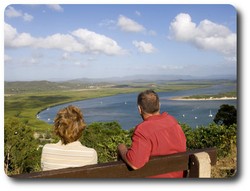Grassy Hill
 Although now quite heavily forested, Grassy Hill is so known because local aboriginals deliberately burnt the forest on the hill to encourage re-growth of vegetation and draw animals to the area for hunting.
Although now quite heavily forested, Grassy Hill is so known because local aboriginals deliberately burnt the forest on the hill to encourage re-growth of vegetation and draw animals to the area for hunting.
The landscape you see today from the top of the hill has changed little since Captain James Cook and the crew of the HM Bark Endeavour climbed Grassy Hill in 1770 to view the surrounding reefs enabling him to navigate a safe passage.
The views today, especially at sunset and sunrise, are still as spectacular as in 1770 making Grassy Hill one of Cooktown's most popular attractions, receiving a certificate of excellence from Trip Advisor.
 The Lighthouse
The Lighthouse
In 1987 residents of Cooktown were threatened with Government decommissioning of the lighthouse. Determined to save the historical facility and amid great media attention, a successful petition and public outcry led to the lighthouse and the area around it being ‘sold’ to the Cooktown people for $100 in 1988.
Thomas Carter was the last lighthouse keeper at Cooktown. He died on Christmas Eve 1918 and he wrote of living on Grassy Hill:
“An ideal spot – 500 feet above sea level – got every breeze that blew; being so far north that was an asset. We had a glorious view towards Mount Cook…. The Endeavour flats for miles, and up to 25 miles to seaward. On clear days with the telescope it was possible to see the surf breaking on the outer edge of the Great Barrier Reef.”
Grassy Hill Radar Station
Cooktown Maritime Radio commenced operations from Grassy Hill in 1913. Established by the Shaw radio Company then taken over by Amalgamated Wireless A’Asia the radio had the call sign VIC and was located east of the lighthouse. It was a large brick and concrete structure with a 200 foot timber antenna supported with guy wires. The outbreak of WW2 saw the radio station become an important part of the local war effort. Cooktown radio closed in 1945 and the tower was destroyed by fire but the buildings were salvaged and are now part of a private residence.




